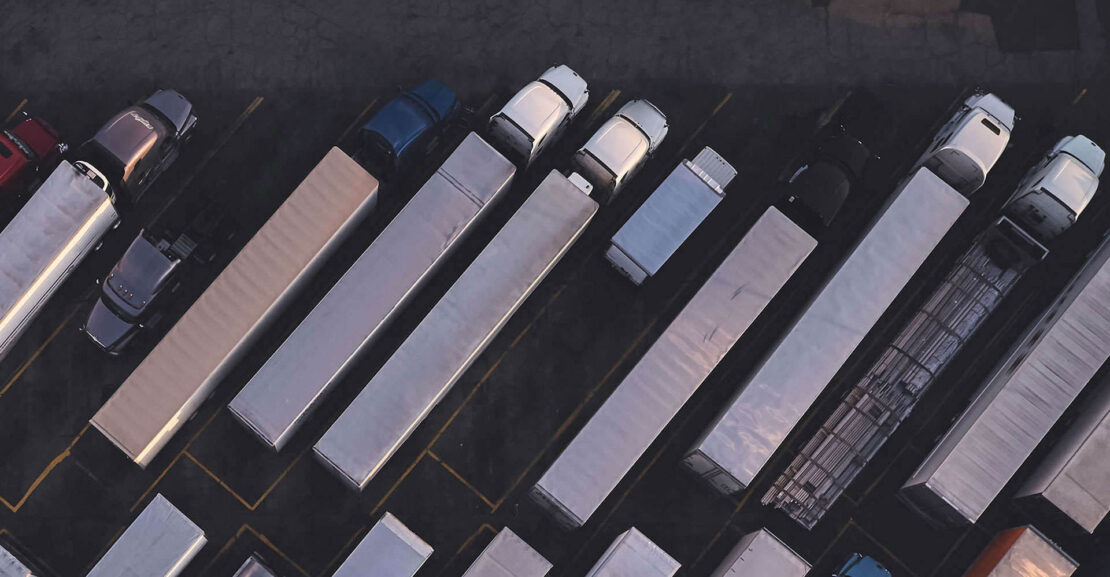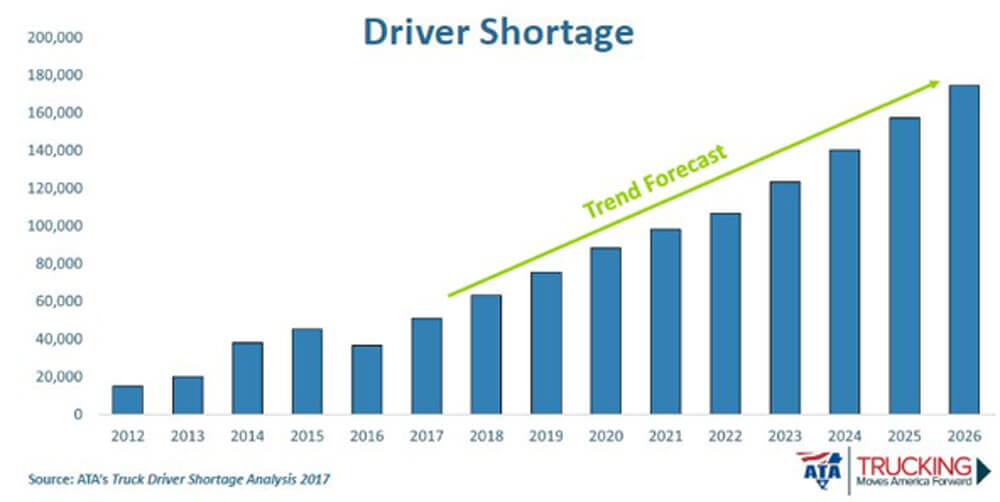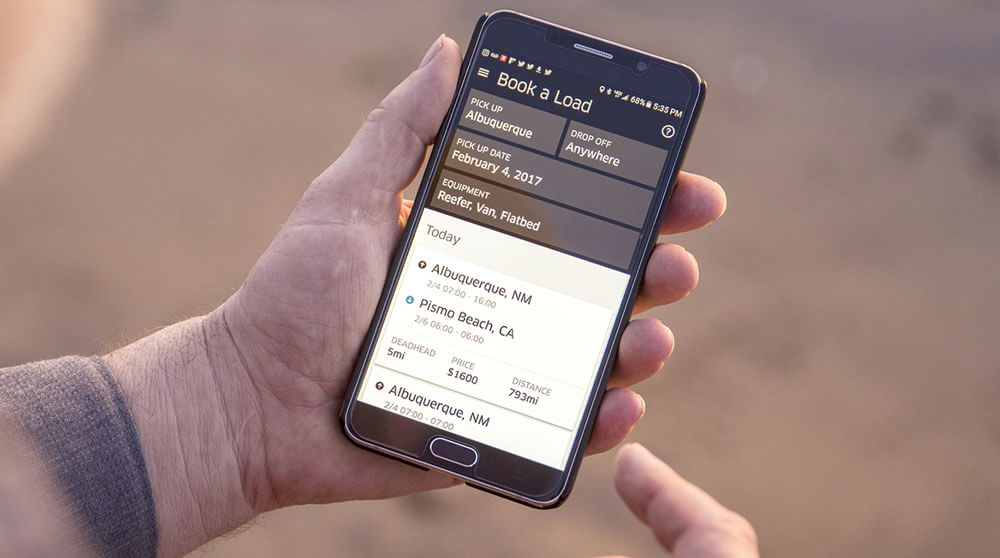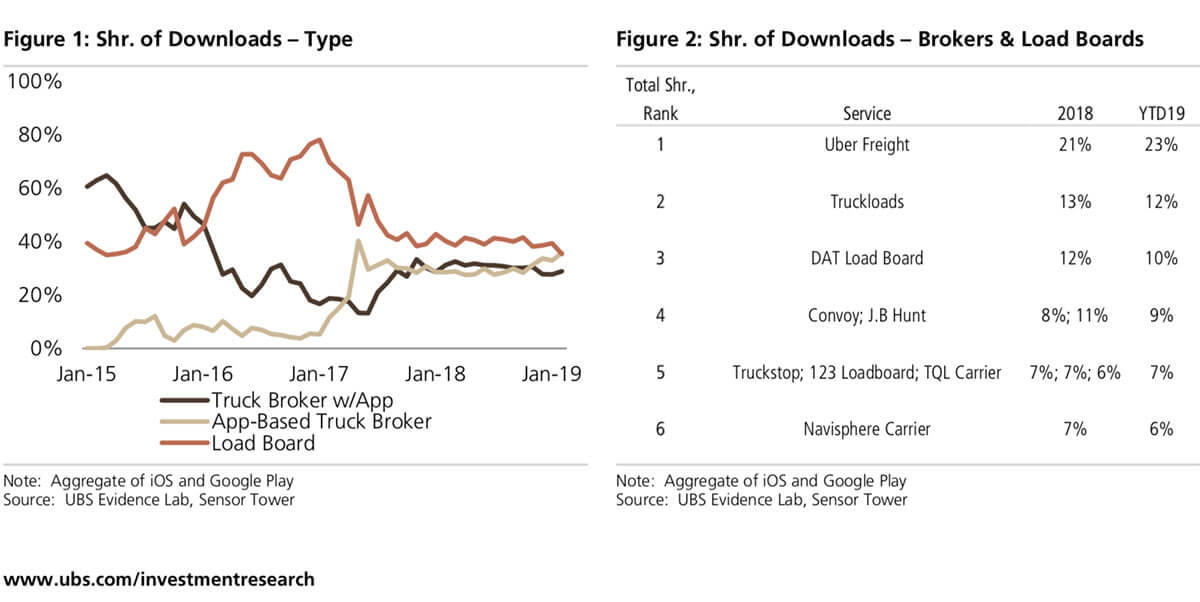Uber Freight: Is the Trucker Shortage Killing the App?

Back in 2017, Uber Freight launched with the goal of allowing truckers to work directly with shippers thus removing the “middleman” from the business. In short, the company translated its “Uber business model” to the logistics industry. The results have been astounding. In the fourth quarter of 2018, the app booked $125 million in sales.
However, the last few months have been less than ideal. Uber Freight has been affected by the truck driver shortage that’s effected the trucking industry as a whole over the last 3 years. This article will explore the Uber Freight’s standing in the market to find out if the trucker shortage is killing it.
The Truck Driver Shortage, a Complex Reality
According to the American Trucking Associations, the truck driver shortage will continue during 2019, but worse, if no action is taken the U.S. will be short 175,000+ truckers by 2026.
How can this be possible? We’ve summarized some of the factors behind the shortage:
- The Trucker Lifestyle– Living on the road is not for everyone. Truck drivers face many challenges while traveling through the country. From a health perspective, the sedentary nature of this job combined with the limited food options available in the road exposes them to many diseases.
- Inability to Get Younger– Let’s face it. Millennials are not interested in becoming truckers. Even when the shortage boosted truckers’ wages well above $87,000 per year, the perspective of being away from home for long periods of time discourages Millennials from starting a commercial truck career. New generations expect to work on high-tech jobs and enjoy the comfort of their homes.
- Retirement Looming– Currently, the average age of truck drivers is 55 years old. Some of them are planning their retirement, but many have already retired due to the increased job pressure caused by the shortage. Combine this with the prior point (lack of youth) and you have a picture of the huge problem ahead.
- Losses Due to High Detention Times– One of the main issues of truckers nowadays is detention time. Theoretically, shippers have a time window for loading/unloading goods. If they exceed this time, they should pay truckers for the detention time. However, in most cases, truckers don’t get paid causing huge loses that increase their frustration making them look for other job opportunities.
The magnitude and implications of trucker shortage is something to worry about. Around 71% of U.S. freight is moved by trucks, the economic impact of not delivering this cargo would be dramatic.

Uber Freight & the Trucker Shortage
Without any doubt, the truck driver shortage is having a negative impact on Uber Freight’s ability to fulfill its mission of matching truckers with shippers. The success of the business is based on the ability to continuously increase its trucker-base as well as its shipper-base. Uber Freight is aware of this, and the proof is their short and long-term strategies to palate the driver shortage.
- Uber Freight Plus Program– 2019, Uber Freight launched an ambitious incentive program that offers discounts on fuel, tires, and maintenance, as well as purchases of new and used vehicles. This represents a huge effort to convince truck drivers of using the app for booking their loads in order to be eligible for these incentives.
- Fast Payments– Uber Freight users have the additional benefit of receiving their pay “within a few days”. Quick payments represent a big plus for most independent truckers that usually have to wait weeks while their check is processed.
- Ability to Rate Facilities– Another push in the right direction is a new feature that allows truckers using Uber Freight to rate the retailers and warehouses they work with. Remember detention times? Truck drivers can now check shipper ratings before accepting a job. This addresses one of the main concerns of truckers. Truck drivers now can rate shippers based on their logistics, timely load/unload, food options, parking facilities, bathrooms, and other relevant factors.
- Autonomous-Vehicles– A sign that Uber Freight is looking for long-term solutions is their bet on autonomous-vehicle technology. The company is investing billions in developing a reliable autonomous-vehicle, although the first generation will be likely semi-autonomous. These vehicles will need a tech-savvy “copilot” behind the wheel/console to ensure everything is working as expected. One benefit of this approach is that the profile for this job could attract millennials since it will be more tech-oriented.
While it is true that some of these incentives and programs are not exclusive of Uber Freight, it’s also true that the company is using any means at their disposal to fight the situation. Is the trucker shortage killing Uber Freight? Potentially, it could. The truck driver shortage can prevent Uber Freight from scaling its operational size fast enough to compete with other freight brokers. Yet, the trucker shortage is not the only issue that could kill the app.

Beyond the Trucker Shortage, Uber Freight Limitations
Throughout this article, the focus has been on one of the biggest problems of the logistics industry in the U.S., the trucker shortage. But what about Uber Freight’s inherent limitations?
- Uber Freight Truck Driver Requirements– Because of the trucker shortage, Uber Freight truck driver requirements for joining the app are minimal. You basically need an active DOT / MC number, no conditional or unsatisfactory safety rating and proof of insurance. Problem is, most large shippers don’t like that policy. They expect to do business with a trusted network of drivers, not only those that meet the minimum legal standards.
- App Limitations– “Uberizing freight industry” seems easy, just implement the proven Uber model and that’s it. Right? Truth is, the logistics sector manages new variables, variables not present in the original model. Special requirements like experience in Hazardous Materials or refrigerated cargo, specific load/unload instructions, specific delivery times and/or location (within the dropship area) are only a few variables. The original Uber App is fully automated, Uber Freight App is not. Sales representatives add inefficiencies and delays that are unavoidable.
- Full Supply Chain Visibility– By no means is Uber Freight a revolutionary app. Freight brokers already were investing heavily in similar solutions. And the truth be told, some achieved better results due to their invaluable experience in the sector. Full supply chain visibility, on-demand fleet, and warehousing reports are only some of the technology challenges that not only Uber Freight but also its competition need to face.

Uber Freight Current Standing
There are several elements that allow an objective analysis of Uber Freight’s current standing in the market:
- The trucker shortage is affecting the whole sector, not only Uber Freight. That means every freight broker is facing the same problem.
- The key for survival will rely on technology investment, driver incentives, creativity, and a deep understanding of truck driver’s needs. Uber Freight is implementing the necessary actions in that regard. Not all competitors will be able to do that, the investment barrier might be too high for some.
- Uber Freight is actively looking for new features that add real value to users. The lack of specific experience in freight business is compensated by Uber’s technology know-how.
- Uber Freight is taking advantage of the Uber brand. That’s logical and necessary. Building trust across large shippers is crucial for the future of this business. Clients like Anheuser-Busch, Land O’Lakes, Niagara Bottling, and Colgate-Palmolive are proof that Uber Freight is putting a huge effort on captivating large customers as well as truckers.
Don’t Miss Out
Stay abreast of trucking industry news and insider information by signing up to the Suppose U Drive newsletter and get content delivered directly to your inbox.

